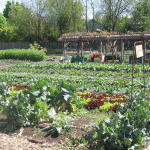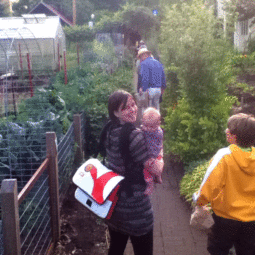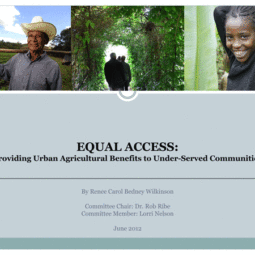It has been easier than I thought in some ways and harder in other ways. The students are, for the most part, complete newbies. I was worried initially that maybe I didn’t know enough to be a mentor to them, but compared to their experience I know plenty.
One of the harder aspects has been making some of this stuff sound as interesting as it really is. Today, for example, I gave them a little lecture about soil life – how compost gets made, what lives in the soil, what is good about beneficial bacteria and fungi, etc. I think this stuff is fascinating, but to a group of 20-somethings a few weeks away from graduating, it’s hard to tell if they agree.
The hardest part of working at the farm has been wrestling with time. Gardeners know it takes time for things to grow in, but it makes me feel impatient for my students when we work in the pouring rain and they don’t get the immediate gratification of picking what they just planted. Instead we have to wait several weeks for the plant to mature. When we plant tomatoes in a few weeks, chances are they won’t even get to taste one we grew because they will graduate before they turn red.
But that is the real experience of tending a garden. You put in a lot of time and labor and sometimes don’t reap what you sow for quite some time. Working in the pouring rain sucks, but it is what we all do as gardeners in the Pacific Northwest.
I find myself spending more time than I thought outside of class trying to research new ideas to keep things interesting at the farm for them. I have started implementing some of the same tactics used in children’s gardens – producing results quickly by planting short-term things like radishes and peas.
This is a bigger responsibility than I think I originally realized. In a way, this is maybe their only chance to get bitten by the urban farming bug. It can be a magical, transformative experience to learn to work with the soil. I just hope I don’t mess it up! Suggestions are mighty welcome









 This has become my
This has become my
 This is from South
This is from South


 All the ornamental grasses get cu
All the ornamental grasses get cu



Check you out…I love the idea of you brainstorming peas and radishes to encourage your students. Congrats on the new gig!
maybe try some sprouts n such as well.. Nearly instant gratification and not even grown in soils.. but it is indeed gardening in a sense.. and in an urban type setting could be an integral one..
I personally am fascinated by soil structure as well. When teaching my environmental science kids, I focus on the Cation Exchange Capacity of soils in order to support life. The pictures of the acidification of the East Coast is enough to normally hook them pretty well.
If people showed up to work in the rain they are interested! I’m sure Mother Nature will win over most of them with a little help from you.
Congratulations on your new job. May you continue to inspire young people for many years.